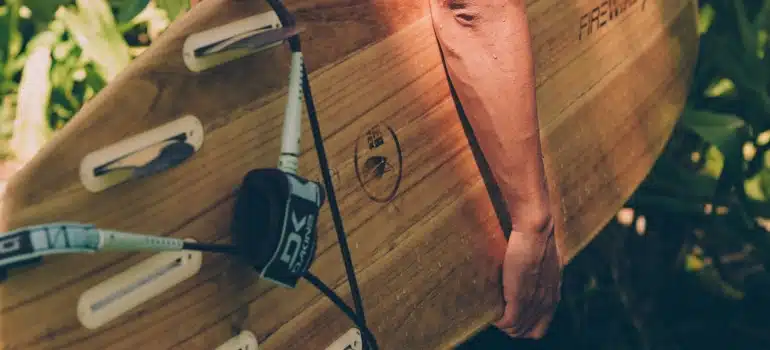Packing and Moving Water Sports Equipment
Moving soon? Packing and moving water sports equipment like paddleboards, wetsuits, or kayaks can be tricky if you don’t have experience handling bulky or sensitive gear. Damage and odors are real risks if you don’t take the right steps. That’s why we’ve created this easy-to-follow guide to help you pack and move your gear safely and efficiently. Our tips are designed to help you avoid common mistakes and protect your equipment throughout the move. With a bit of planning and organization, you and your family can handle packing and moving water sports equipment without hassle. Don’t risk damaging your valuable gear; contact Pro Movers Miami for a safe, professional moving experience.
Why Proper Packing of Water Sports Gear Matters
Water sports gear is often costly and delicate, making it especially vulnerable during a move. Salt, moisture, and rough handling can cause mildew, cracks, warping, or even permanent damage. Without proper packing, your favorite equipment might not survive the journey. Taking the time to pack it correctly or hiring professionals can protect your investment and ensure it’s ready for your next adventure.

Step 1: Clean and Dry Everything First
Before you pack a single item, cleaning and drying your water sports equipment is a must. Saltwater residue, sand, algae, or even freshwater moisture can silently wreak havoc during transport, leading to mildew, corrosion, or material breakdown. Take the time to thoroughly rinse each item, then dry it completely, preferably in open air. Packing wet gear not only risks damage but can also produce strong odors in transit. This step is especially important for:
- Surfboards and paddleboards
- Wetsuits and life vests
- Snorkels, fins, and masks
- Kayaks, canoes, and rafts
Step 2: Gather Packing Materials
Your gear deserves protection, and not all packing materials are created equal. Cheap boxes and thin plastic can lead to busted seams, water exposure, or shifting damage during transit. Instead, try to find the best possible moving supplies there. The better the moving supplies you find, the better the chances of your water sports equipment arriving safely. Use:
- Bubble wrap and padded covers to cushion delicate gear
- Tarps and waterproof duffle bags to guard against moisture
- Hard cases or board bags for boards and paddles
- Plastic totes or bins for smaller accessories

Step 3: Get Help
Moving bulky or delicate gear can be overwhelming, especially if you’re relocating a full household. Don’t hesitate to ask close friends or family members to lend a hand – just be sure to give them plenty of notice so they can plan ahead. An extra set of hands can make packing and loading much smoother, particularly when dealing with oversized items like kayaks or paddleboards.
If the task still feels daunting or you’re short on time, consider hiring professionals. Look for long distance movers in Miami who specialize in handling fragile, odd-shaped equipment and offer protective materials like waterproof wraps or hard crates.
Most importantly, request a free moving estimate before committing. A clear, upfront quote helps you understand what’s included, avoid hidden fees, and plan your budget with confidence.

Step 4: Start Packing Your Water Sports Equipment
Once your gear is clean, dry, and you have all the right materials on hand, it’s time to pack each item with care. Different types of water sports equipment require different packing strategies to ensure they stay protected during transit. Below are tips for safely packing some of the most common pieces of gear, so everything arrives at your new home in top condition.
How to Pack a Kayak for a Move
- Clean thoroughly: Remove sand, salt, or debris. Let it dry completely.
- Protect with padding: Wrap the body with moving blankets or bubble wrap, focusing extra padding on the hull and ends.
- Secure loose parts: Remove and pack paddles, seats, and foot braces separately in labeled boxes.
- Use a kayak bag if available: This helps prevent scratches and UV damage.
- Strap it down safely: When loading into the truck, place it on foam blocks or blankets and secure it using ratchet straps. Load it on its side or top-down, depending on the shape and material.
How to Pack a Stand-Up Paddleboard (SUP)
- Rinse and dry thoroughly before packing.
- Use a padded board bag for maximum protection.
- Wrap the paddle separately and pad the ends.
- Place foam or soft blankets under the board if lying flat inside a truck.
- Avoid pressure on the center to prevent cracking; stack only lightweight items on top, if any.
- Strap the board snugly to a wall or side panel to prevent it from sliding.
Consider hiring local movers in Florida if you’re transporting expensive or oversized gear. Experienced movers know how to secure bulky water equipment without damage, giving you one less thing to worry about.
Keep Your Water Sports Gear Safe with the Right Moving Strategy
Packing and moving water sports equipment may seem like a challenge, but it doesn’t have to be. With the right preparation, high-quality packing materials, and a little help from experienced movers, you can relocate your gear without stress or damage. Whether you choose to do it yourself or bring in professional movers in Miami, the end goal is the same: to ensure your boards, wetsuits, kayaks, and accessories arrive safely and are ready to hit the water again. A successful move starts with a smart plan. Take the time to clean and prep each item, use protective materials that work, and don’t hesitate to lean on trusted services like Pro Movers Miami when you need expert handling. After all, your gear isn’t just equipment, it’s part of your lifestyle. Keep it protected, and you’ll be ready for your next adventure from day one.
FAQs
Can I move my paddleboard without a hard case?
Yes, but make sure to wrap it securely in padding and lay it flat between soft, stable items to avoid dents or pressure points.
What’s the best way to move wet gear?
You shouldn’t move wet gear at all. Always allow everything to dry completely to prevent mildew and strong odors.
Should I deflate inflatable kayaks before packing?
Fully deflate, clean, and dry inflatable kayaks before rolling them up and storing them in a waterproof bag or container.
